‘And the woodbine spices are wafted abroad’ - newly opened wild honeysuckle at the edge of the heath, 2 June 2023.
Come into the garden, Maud,
For the black bat, night, has flown,
Come into the garden, Maud,
I am here at the gate alone;
And the woodbine spices are wafted abroad,
And the musk of the rose is blown.
For a breeze of morning moves,
And the planet of Love is on high,
Beginning to faint in the light that she loves
In a bed of daffodil sky,
To faint in the light of the sun she loves,
To faint in his light, and to die.
All night have the roses heard
The flute, violin, bassoon;
All night has the casement jessamine stirr'd
To the dancers dancing in tune;
Till a silence fell with the waking bird,
And a hush with the setting moon.
Alfred, Lord Tennyson, from Maud (Part 1)
Swallow Moon rising over the cliff path, 9.45pm on Saturday 3 June 2023, just a few hours from full.
Happy full moon in Sagittarius!
This moon is often called the Strawberry Moon, marking the ripening of strawberries that are ready to be gathered at this time. As flowers bloom and early fruit ripens, June is a month of great abundance in many different landscapes and climates.
While the Native American peoples gave a wide variety of names to the other moons, the June full moon is known as the Strawberry Moon to nearly all of the tribes; the Algonquian in the northeastern United States as well as the Ojibwe, Dakota and Lakota peoples.
But while you will mostly see this moon listed as the Strawberry Moon, there are other names if you look around. The Haida tribe’s Berries Ripen Moon is a little more literal, while Blooming Moon (Anishinaabe) speaks of the flowering season. The Cherokee tribe called the June moon Green Corn Moon, honouring the young crops.
For other cultures, this is primarily a time of new life. The Tlingit people called this the Birth Moon, as it’s the time when certain animals are born in the Pacific Northwest. Egg Laying Moon and Hatching Moon are Cree names that tell the same tale.
Alternative European names for this moon include Honey Moon, Mead Moon and Rose Moon. Juno, Roman goddess of marriage and childbirth, gave her name to June which is traditionally the month for marriages. So surely it’s no coincidence that a wedding is followed by a ‘honeymoon’?
Looking at these names I would be torn between Honey Moon and Rose Moon, since I adore both honey and roses! But in the spirit of making my own moon name that relates closely to the land around me I’m going to plump for either Mugwort Moon or Swallow Moon. How about you?
Now summer is in flower and nature’s hum
Is never silent around her sultry bloom
Insects as small as dust are never done
Wi’ glittering dance and reeling in the sun
And green wood fly and blossom haunting bee
Are never weary of their melody
John Clare, from June in The Shepherd’s Calendar
Two Years Ago - 3 June 2021
Sunset between the medieval church tower and the sea below. It was a total surprise to me that I was out late enough to see it, let alone to witness the lighthouse’s first flashes, barely perceptible in the twilight.
But that’s what happens when a coffee stop on the cliff turns into a beach walk which becomes a seaweed forage. Add to that a worried search up and down the darkening beach for my backpack, before discovering that two well-meaning ladies had ‘rescued’ it from the incoming tide, and it’s probably not surprising that a rosy hue was gently unrolling around the horizon by the time I headed back across the former caravan site on the crumbling cliff top.
Sunset from the ghostly campsite, 3 June 2021.
This Time Last Year
… Glancing down the slipway, I noticed dark shapes moving in the half-light. People had begun drifting down to the beach. The light had faded quite suddenly, leaving an achingly beautiful sea edge as the wavelets caught the last pink rays of the setting sun. Of course I found myself down there too, still weirdly invisible and liking the sensation. Half way around the bay, I spun on my heel to gaze at the tableau on the cliff top.
The beacon’s birth had been humble enough. Even the keeper of the flame had seemed a little apologetic at the lack of spectacle. But now the logs had taken hold, and the pyramid blazed. Beyond, the sky was losing its indigo and becoming ever more deeply inked. Set against it, silhouetted, groups of people were still perched on the edge of the cliff. I wondered why they hadn’t moved on. Perhaps it was the unspoken and almost innate sense of occasion or perhaps they were deep in conversation about something else entirely.
Faintly and incongruously, the distorted strains of the Chi-Lites fell down to where I stood. Those huddles of humans, the flame, the sea. Suddenly the scene felt like something far more ancient. And above the lighthouse and the tiny figures hung the crescent moon, slim and bright and lovely…
Beach, sea, cliff, beacon, people, moon - Queen’s Jubilee, Happisburgh, 2 June 2022.
The Stags
‘These our actors,
As I foretold you, were all spirits, and
Are melted into air, into thin air.’
William Shakespeare, The Tempest
I still can’t really believe that my pair of stags down by the stream weren’t an otherworldly vision or a glimpse into the realm of faerie.
Stags by the stream, 4 June 2022.
Swallows
Given the dangers and capricious moods of the sea, it’s not surprising that sailors traditionally had their own complex superstitions and lucky sea-charms. Mariners have always been known for their love of tattoos, each with its own layers of meaning. Swallows were (and are) commonly seen. Every swallow was a proud emblem of having voyaged over 5000 nautical miles, but they also had a crucial protective role to play.
Despite their long and perilous flight over the oceans, swallows will always find their way back to their own nest. With the help of his swallows, the sailor too would reach his home safely after every voyage. When the crew could see swallows swooping and skimming the waves they knew that land and loved ones were not far away.
And the more swallow tattoos the better, since these same swallows would carry to heaven the souls of sailors who succumbed to the icy fingers of the sea.
Down on the beach under the cliff, generations of sand martins have made hundreds of nest-holes and their acrobatics are a joy to behold as they dive in and out all summer long. Like the swallows, they journey countless miles to come back to this corner of Norfolk every single year.
What could be more reassuring than that?
Sand martin nest holes at Happisburgh.
A swallow finds a temporary home :)
Saint Petroc and the Dragon
On the third day, I heard a step which I recognised, and the next moment, there was Saint Petroc beside me.
‘Why, Brother Dragon!’ he cried, and stroked my head. ‘What’s happened to you?’
He examined my eye carefully, and thought for a moment. Then he turned to the monk who had been bathing it and said:
‘This poor beast is half blinded. Take a jug of the spring water and mix it with some of the dust from the floor of our church, and pour this over the dragon’s eye.’
Then he patted my head again and went his way. He was a very busy man. And the monk did as Saint Petroc had told him, and as soon as he poured the water over my head and into my bad eye, the splinter of wood dropped out, and I could see as well as before. So I rubbed the monk up and down with my head, just to show I was grateful, and, waving my tail joyfully, I walked the twenty miles back to my seashore again.’
Rosemary Manning, Green Smoke.
Today, 4 June, is the feast day of Saint Petroc (c.468 - c.564) one of the early saints of Cornwall. For reasons I shall tell you in a moment I have known of this saint since I was about six years old. But I only discovered some amazing things about him a day or two ago.
Probably born in South Wales, Petroc ministered throughout Dumnonia which included what we now know as Cornwall and parts of Devon, Somerset, Dorset and Brittany. Having studied in Ireland he made a pilgrimage to Rome, and on returning to Cornwall founded a monastery and school at the mouth of the River Camel on the north Cornish coast at a place that came to be called Petrocs-Stow (Petroc's Place), now Padstow. This appears to have been his earliest cult centre, but Bodmin became the major focus of veneration when his relics were moved to the monastery there in the later ninth century. By the eleventh century Bodmin monastery was one of the wealthiest Cornish foundations. There is a second ancient dedication to him nearby at Little Petherick or Saint Petroc Minor where he founded another church, and many other examples primarily in Cornwall and Devon.
Saint Petroc is said to have converted Constantine of Cornwall to Christianity by saving a deer Constantine was hunting. Constantine later established a hermitage at what is now called Constantine Bay. Take note of this ;)
One story about Petroc describes his return from the pilgrimage to Rome and Jerusalem. As he arrived back on British soil under heavy rain, he confidently told his companions that it would clear up by morning. Instead, the downpour lasted for many days and Petroc, ashamed of his presumptuousness, is said to have left on another pilgrimage, this time one of penance. Legend relates that he travelled as far as India where he is said to have tamed a wolf. In iconography, he is frequently depicted with the wolf and also, like several other British saints, with a stag.
This - along with his dragonish connections (of which more in a moment - definitely makes him what Jacqueline Durban of Radical Honey has termed a Wild Antlered Saint :)
Sadly, the mortal remains of this gentle and humble man were not left to rest in peace. In 1177, a Breton stole his relics from Bodmin and gave them to the Abbey of St Meen in Brittany. Henry II ‘restored them’ (whatever THAT means) but that was not the end of the unrest as the relics were thrown out during the Reformation and are said to have ended up in the bay of Hailemouth near Padstow. The ivory casket that once contained them can still be seen at St Petroc’s in Bodmin.
Now, why do I say I discovered some ‘amazing’ things about Saint Petroc? In a way it’s all amazing as I didn’t actually know anything about his life before. I suppose I just took his presence for granted in the whole chapter named after him in one of my favourite books from early childhood, Green Smoke by Rosemary Manning. Our hero the Cornish dragon has been alive for more than 1500 years, which has naturally given him the opportunity of coming across Saint Petroc in his earlier days when he was fearsome and fire-breathing.
The dragon - or R. Dragon, to give him his (nearly) full name - lives in a cave in a rocky bay on the Cornish coast, where the story is set. This is a young children’s story remember, so you might think the author wouldn’t worry too much about tying everything together conceptually. But I love and appreciate that kind of thing: taking extra trouble even in the bits that don’t show.
Can you guess where the dragon lives?
Yes, Constantine Bay.
Saint Petroc’s Rock Pool Buns
These are like a cross between a cookie and a bun, chosen to pay tribute to Saint Petroc’s rocky home in Cornwall - and the second syllable of his name! Rocks and caves crop up again and again Cornish folklore, and indeed the Dragon himself lives very comfortably in his cave, feeding himself on the left-over picnics of the ‘trippers’. In Green Smoke, Sue wins the dragon’s friendship by sharing her morning bun with him each day, which is another reason this recipe felt so appropriate. I’ve visited Constantine Bay myself, and although the Dragon didn’t come out to greet me I did see plenty of rock pools.
100g coconut sugar
115g plain flour
1 tsp baking powder
70g moist peanut butter
50ml plant-based milk
1 tbsp melted coconut oil
15 tsp naturally-sweetened jam
Pre-heat oven to 180C/160C fan/350F. Line a 25 x 30cm baking tray with parchment. Place the coconut sugar, flour and baking powder into a bowl and whisk until no lumps remain.
Add peanut butter, plant-based milk and coconut oil. Mix to a firm dough.
Use a a tablespoon to scoop 15 pieces of dough and roll into balls. Space evenly on baking sheet.
Indent each ‘rock pool’ with your thumb. Fill with a small amount of jam.
Bake for 12 minutes until golden. Remove and leave to cool on the tray, on a cooling rack, before eating.
Along the Lane
Come for a walk with me down the lane and over the heath. The sharp early aromas have melted into sweet heavy florals and musks. Elder and the newly-opened honeysuckle hold sway over the hawthorn blossom become pink and rank. The white froth of cow parsley dulls now, as tiny petals scatter to the winds. The horse chestnut candles have had their burst, illuming the lane for a breathless moment before guttering out and turning their wicks earthwards to begin again.
The russet shape over there. Is it a muntjac? Yes, the curved smooth back and flicked up tail give it away as it saunters across. A long way off from us; no rush on this quiet still morning.
The gorse has had its day - for now, at least. The gold is dimmed, sheathed in papery brown that fades into the twigs and dried spines. It’s the wild woodbine’s moment, and that means that the best time for a walk will be just at dusk when the scent hangs over the lane. Perhaps the bats will be out. Yesterday, swallows circled the cottage and my heart sang.
Are you with me? Kettle’s on for our return.
With love, Imogen x
Yesterday evening - sunset in one direction while the full moon rose in the other. 3 June 2023
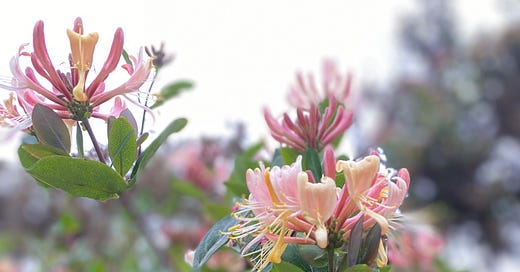






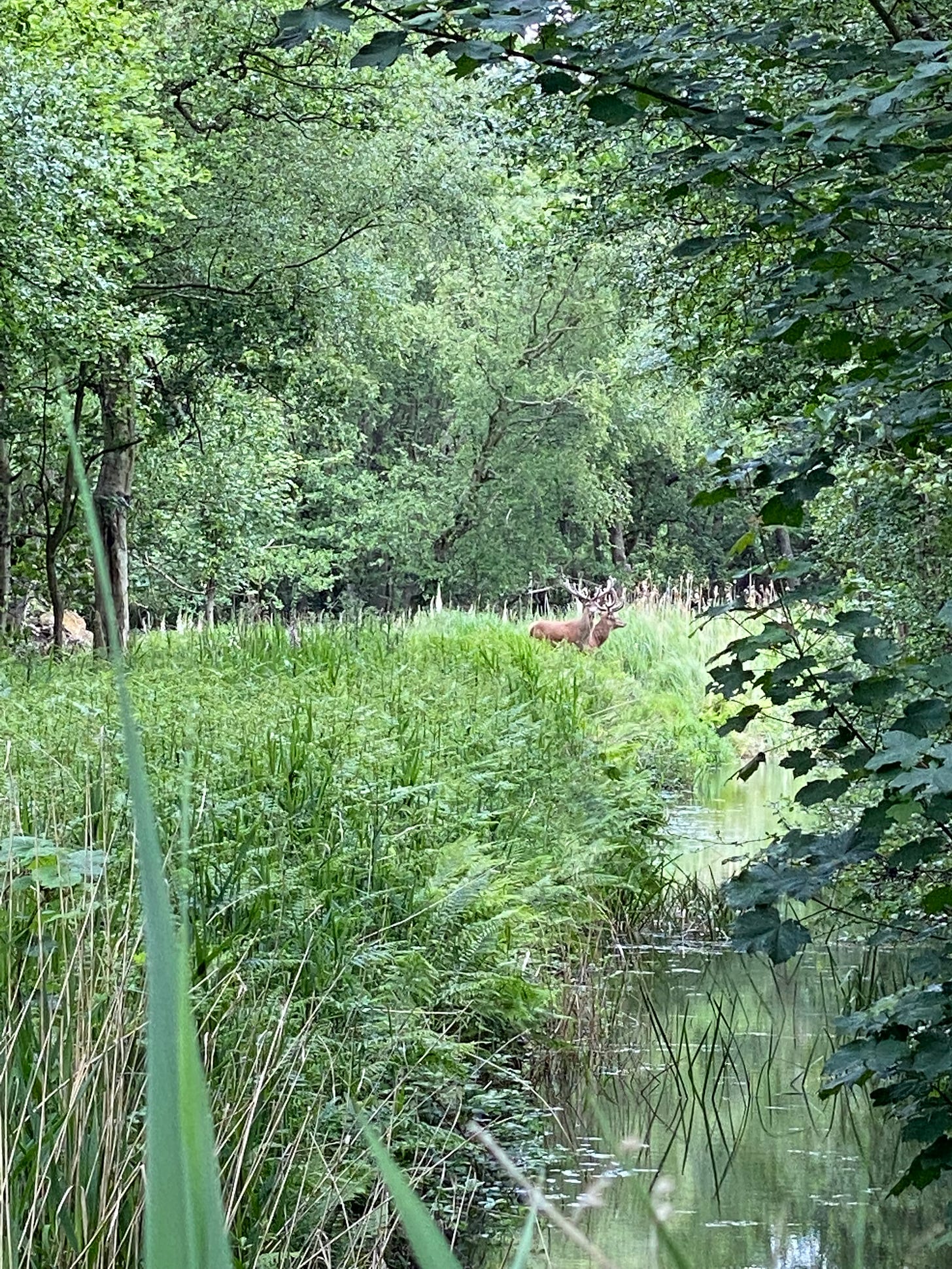
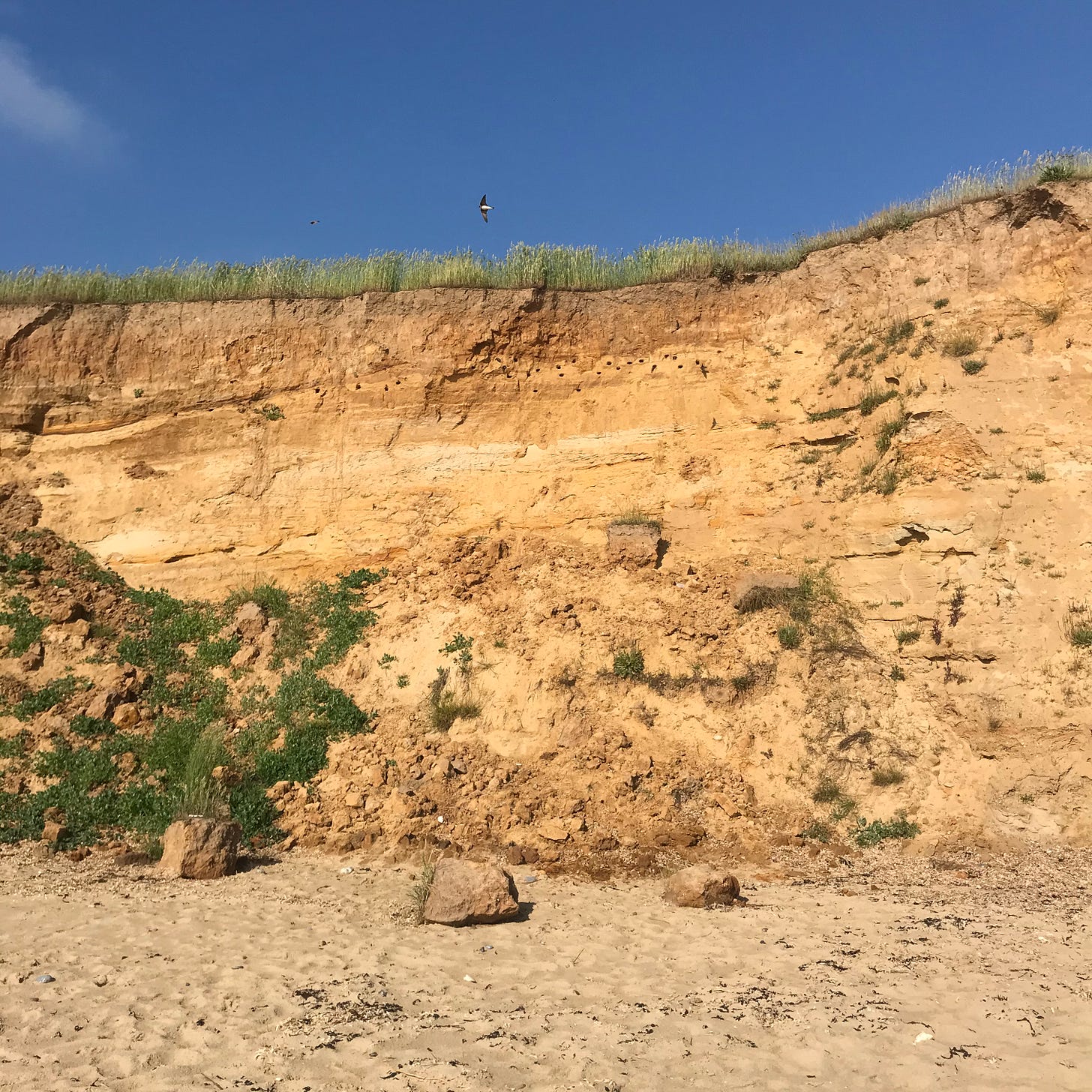

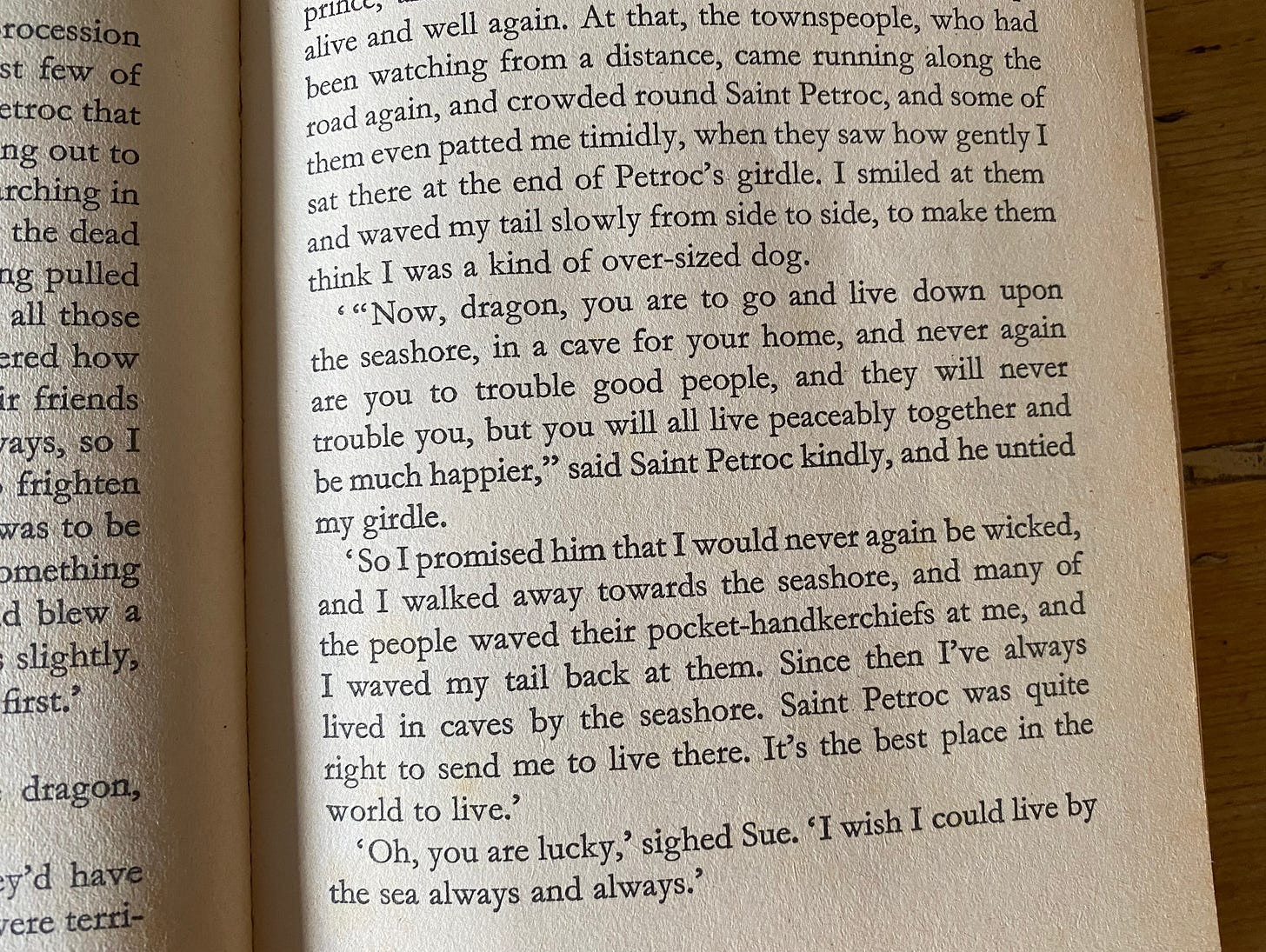
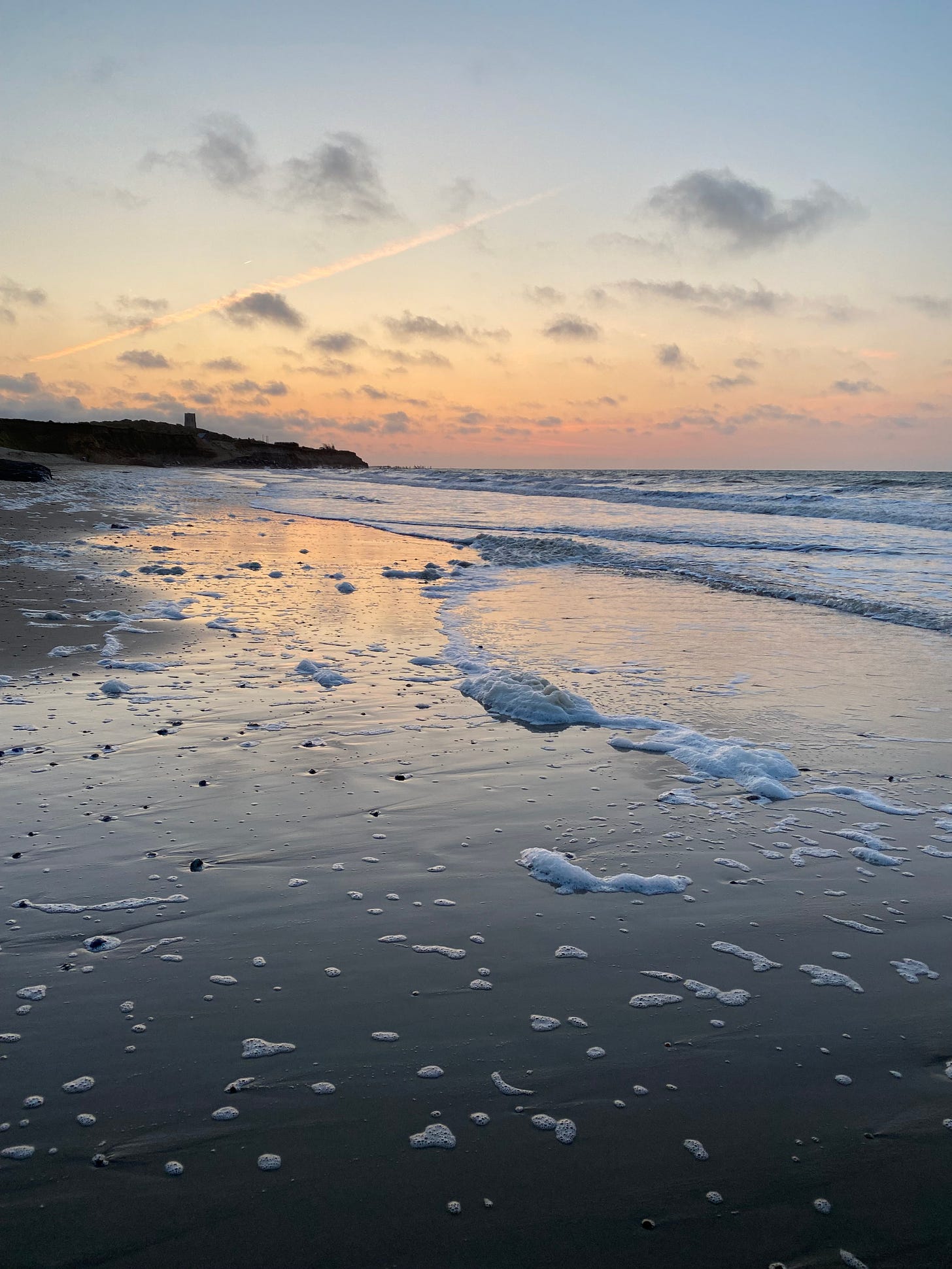
Thank you so much for this, Imogen. What a beautiful meditation on early summer and so full of wonderful information and enchantments. I would have loved it just for your use of the word 'woodbine', but there is so much more besides. I love the story about St Petroc. He definitely has antlers! I am also thinking about what I might name this moon. I try to do this often in order to have more personal names but I find the pre-existing ones so intoxicating that I can never settle on anything else. Maybe Fledgling Moon...
Imogen as I read the opening line of the poem “Come into the garden Maude” I was transported back to my maternal grandma’s garden as she would always say that whenever we went through to her and my Auntie June’s pretty little cottage garden, I never knew why she said that and it just became a family saying, now it makes sense as she was a real poetry lover and it must have been from this beautiful poem. Your writing as always brings such joy and I always learn lovely little nuggets of information. Thank you for sharing and many blessings to you.